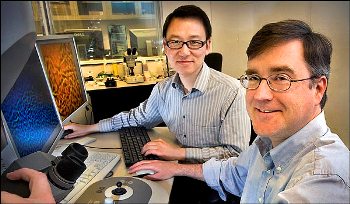Researchers from the Brookhaven National Laboratory of U.S. Department of Energy have discovered the nanoscale arrangement of a new form of carbon.
The discovery explains how the new carbon functions as a super-absorbent sponge when absorbing electric charge. The new material developed at The University of Texas – Austin can be easily added to energy-storage devices that have high storage capacity.
 Dong Su and Eric Stach use a powerful electron microscope to analyze samples of activated graphene at Brookhaven’s Center for Functional Nanomaterials. Says Stach: “The CFN provides access to scientists around the world to solve cutting-edge problems in nanoscience and nanotechnology.
Dong Su and Eric Stach use a powerful electron microscope to analyze samples of activated graphene at Brookhaven’s Center for Functional Nanomaterials. Says Stach: “The CFN provides access to scientists around the world to solve cutting-edge problems in nanoscience and nanotechnology.
Supercapacitors function like batteries because both are utilized to store electric charge. Batteries store electric charge by means of chemical reactions between a liquid electrolyte and metallic electrodes. Since these chemicals take some time to respond, energy is captured and produced slowly. However, a lot of energy can be stored in batteries and can be released over an extended period of time. Supercapacitors can store the electric charge as ions on the electrode surface instead of depending on chemical reactions. While charging, the electrodes make the ions in the electrolyte to polarize or segregate so that the charge gets accumulated between the electrolyte and the electrodes. Most supercapacitors do not have the capacity to store as much charge as possible like batteries.
The supercapacitors, made from the new material, have energy density, which is similar to the energy-storage capacity of lead-acid batteries. The UT-Austin researchers had started to develop a porous form of carbon by utilizing potassium hydroxide to reorganize graphene platelets that are altered chemically. Since this new carbon material was better than other materials utilized in supercapacitors, there is no necessity to delineate its composition at the nanoscale. The processing techniques applied to develop the new form of carbon can be applied to industrial production.